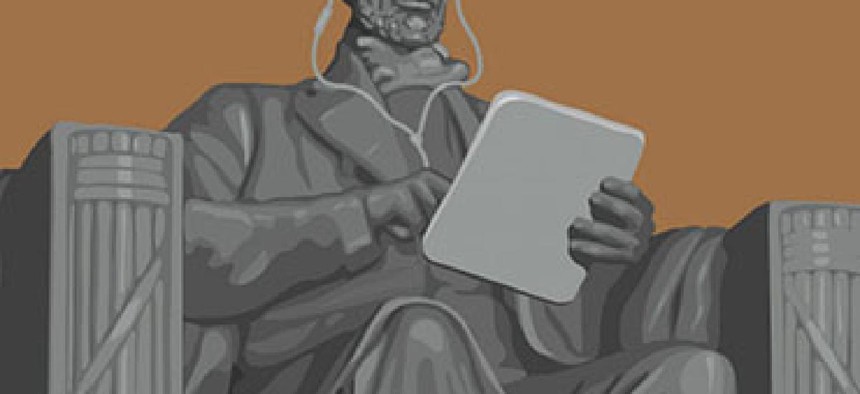Deloitte study: Mobile can help feds 'hit the reset button'

Agencies lag far behind the private sector in embracing mobile, but that means big productivity gains are still to be had.

Government's productivity has fallen while the private sector's has grown, which a new Deloitte analysis atttributes in part to differing approaches to technology, especially mobility. (Deloitte image)
The federal government has so far failed to fully harness the power of mobile technology to increase its productivity, but there is still time to "hit the reset button," according to a study released by Deloitte Consulting.
The study, "Gov On the Go: Boosting Public Sector Productivity by Going Mobile," shows that corporations have reaped the rewards of embracing mobile technology and suggests that doubling mobile adoption rates in federal agencies could generate $50 billion in added value annually.
The private sector has harnessed "the disruptive power of technology" to invent better and more efficient processes, and as a result its productivity has grown 50 percent over the past 25 years, the study shows. The government has failed to do so effectively, and its productivity has decreased over the same period.

Charting the difference in productivity growth between the private and public sectors. (Deloitte graphic)
Yet the government still has plenty to gain through mobility, said Rob Frazzini, a principal at Deloitte and leader of the federal digital practice. With smart phones now outselling PCs and people increasingly relying on their mobile devices for work as well as personal purposes, the time is ripe for the government to jump on the mobility bandwagon.
"We look at this mobile revolution as an opportunity for government to really not only cut costs, but to increase constituent value and increase efficiency of the workforce considerably," Frazzini told FCW. "Mobile isn't just cool because it's on your device. The big game-changer with mobile is that the user becomes the center of the universe. It's user-centric on steroids."
The report, authored by William Eggers and Joshua Jaffe, found:
• If mobile-generated productivity reduced new U.S. federal government hires by even 10,000 over a decade, the corresponding lifetime salary and pension savings could exceed $25 billion.
• Mobile data access can help police officers save 30 minutes every day. Assuming that half of the 636,410 officers in the U.S. lack access to this technology, adopting it could save them more than 50 million hours or $1.3 billion.
• Greater mobile adoption by caseworkers could result in 57 million additional hours of services to the community annually.
• In the past 25 years, the productivity of America's private sector has risen by more than 50 percent, while the productivity of its public sector decreased.
The challenge of embracing mobility
While the Deloitte study highlights successful instances of federal entities like the Air Force adopting mobile technologies that realize big savings, big obstacles make adopting mobile technology difficult for many agencies. Privacy and security of sometimes sensitive data are among them, as are concerns over cost, though Frazzini said mobile technology ultimately provides a much higher cost benefit than legacy technologies.
"If you put cost implementation of legacy against mobile, cost savings are more on the mobile side, you save more on the mobile side with training, and you gain more good will by your employee base and your constituency," Frazzini said. "And you're not looking archaic."
Even with mobility consistently trending as one of federal IT's most popular buzzwords, Frazzini said policy remains the biggest roadblock to more widespread mobility adoption.
"We have to start at the policy levels," Frazzini said. "Why the government is lagging substantially is not because there aren't tech companies pitching solutions or business process solutions in the mobile arena, it's that some business processes the government has are so far behind the times."
But the pressure is building on agencies to go more mobile, and it's coming from the top and the bottom of the federal totem poles.
The White House's Digital Government Strategy, released in 2012, outlined government-wide mobile adoption, putting the onus on agency heads to strategize how to make use of mobile technology's inherent advantages. Often overlooked though, Frazzini said, is that agencies are struggling to attain, attract and retain new talent. Young workers – the people who grew up with iPhones in their hands and Facebook accounts in high school – want to work for employers who "get it."
"You're seeing a top-down squeeze to adopt this culture, and a bottom-up squeeze, and the government will not retain new talent if they don't offer these solutions," Frazzin said. "It's just not going to happen."
Cindy Auten, general manager for Mobile Work Exchange, said agencies are clearly interested in expanding their use of mobile technologies.
Mobile Work Exchange, which hosts a global effort to encourage agencies and organizations to telework from mobile devices during the week of March 4, already has 96,000 pledges for this year's event, almost 30,000 more than last year. Initiatives like the Digital Government Strategy and Telework Enhancement Act, she said, are beginning to change how agencies view mobility.
"We've received an outpouring from federal agencies, its expanding nationwide and the impact is going to be tremendous," Auten said, noting that some agencies are ahead of others.
"But across the board, we're seeing a lot of improvements in mobility," Auten said.

Expanded telework could increase government productivity. (Deloitte graphic)
Note: This article has been updated to correct the release date of the White House Digital Government Strategy.






